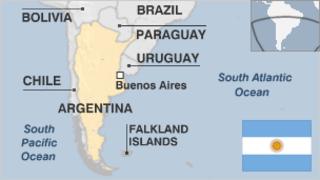Home » Latin America »
Argentina country profile
Argentina stretches 4,000 km from its sub-tropical north to the sub-Antarctic south.
Its terrain includes part of the Andes mountain range, swamps, the plains of the Pampas and a long coastline.
Argentina is rich in resources, has a well-educated workforce, and is one of South America’s largest economies. In cultural terms, it has given the world major writers like Jorge Luis Borges, and the tango dance phenomenon.
But its political life has been troubled by military coups and the vagaries of the populist Peronist movement, while the economy has been prey to dramatic booms and recessions.
See more country profiles – Profiles compiled by BBC Monitoring
FACTS
Argentine Republic
Capital: Buenos Aires
Population 44 million
Area 2.8m sq km (1.1m sq miles)
Major language Spanish
Major religion Christianity
Life expectancy 73 years (men), 80 years (women)
Currency Peso
LEADER
President: Mauricio Macri
Mauricio Macri defied expectations by winning the 2015 presidential election run-off, beating Peronist candidate Daniel Scioli to become the country’s first unambiguously conservative president to win a free and fair election since 1916.
Born into a wealthy business family, Mr Macri was elected mayor of Buenos Aires in 2007, and later emerged as the leader of a reunited conservative opposition to left-wing Peronist presidents Nestor Kirchner and Cristina Fernandez while the economy took a downturn.
He promised to press ahead with austerity measures following his victory in mid-term parliamentary elections in October 2017, and had to raise interest rates dramatically in the spring of 2018 in an effort to shore up the tumbling value of the peso currency.
MEDIA
Argentina has one of South America’s biggest media markets.
TV is the dominant medium and the main networks are operated by large privately-owned companies.
The media are generally free from official censorship.
The country has one of the region’s highest rates of internet use. Facebook is the top social platform.
TIMELINE
16th century – Spanish colonisation of the River Plate coast and inland areas begins.
1810-18 – War of Independence ends in separation from Spain, but is followed by a series of civil conflicts between centralist and federalist forces until 1880.
1916-22 – President Hipolito Yrigoyen enacts a series of progressive social reforms. He is re-elected for another stint as president in 1928.
1930 – Great Depression hits Argentina hard as demand for its agricultural exports dries up. Armed forces seize power in coup, setting a precedent for military intervention that only ends in the 1980s.
1955 – President Juan Peron, an authoritarian populist who drew his support from Argentina’s poor, is ousted in coup as the economy goes into decline.
1976 – Armed forces seize power from another Peronist government and launch ‘Dirty War’, in which thousands are killed on suspicion of left-wing sympathies.
1982 – Argentine military invade British Falkland Islands in South Atlantic, but are expelled months later by British armed forces after bloody battles. Military government falls the following year.
2001 – Economic crisis. Argentina makes history with the largest ever sovereign debt default of more than $80bn (£42bn). Peronist government of President Nestor Kirchner restores stability.
2015 – Conservative President Mauricio Macri launches programme of market reforms to reign in state role in economy.
Source: Read Full Article



